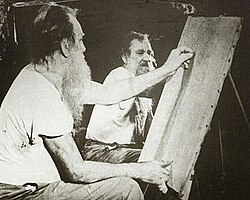Armando Reverón
| Armando Reverón | |
|---|---|
 |
|
| Born |
Armando Julio Reverón May 10, 1889 |
| Died | September 18, 1954 (aged 65) |
| Nationality | Venezuelan |
| Known for | Painting, drawing, sculpture |
Armandro Reverón (1889–1954) was a painter and sculptor in Venezuela in the late 19th and early 20th centuries, and arguably the most influential exponent of Venezuelan impressionism. While his mental health deteriorated throughout his life, his artistic abilities remained. His house by the northern coast of Venezuela housed the Reveron Museum, although it was severely damaged by the Vargas mudslides in December 1999. He is the subject of various homages in different media, and is remembered by his "muñecas" or dolls.
He began his studies at the Colegio de los Padres Salesianos in Caracas. His maternal great-uncle, Ricardo Montilla, who had studied in New York, teaches him natural drawing and awakens his artistic vocation; his interest in painting was manifest from childhood. In 1896 he was transferred to Valencia after the failure of his parents' marriage. Armando is sent home from Rodríguez-Zocca's family, who took care of his early education.
Under the care of Rodríguez-Zocca's family, Reverón established a close relationship with Josefina, the daughter of the couple, and came to appreciate her like his own sister. The walls of the house were some of the first paintings of Reverón, where he attempted to portray the family maid, Juanita Carrizales. Rodríguez-Zocca's described Reverón´s temperament as "sad, angry and melancholic". Between 12 and 13 years, he suffered typhus, which many believe psychically affected him for the rest of his life.
Reverón built several ranches in the terrain that he bought in Macuto, the principal ranch was his workshop; the walls were timber and the roof thatched. Around his waist he placed a large bag to hold his driftwood-made brushes.
The decision to move also coincided with a change of behavior and of course, a transformation of his artistic concepts. During this period, by adopting primitive habits and detached from the city, Reverón could develop a deeper understanding of nature; this led him to develop his particular method of painting using native elements, and adopting procedures and materials that suited his desire to represent the atmosphere of the landscape under the dazzling effects produced by direct sunlight, which also created color values and devised new media.
Thus entered what the critic Alfredo Boulton called his Período Blanco, located roughly between 1924 and 1932. The GAN (Galeria de Arte Nacional) possesses an important collection of photographs by Alfredo Boulton of Reverón. These photographs contain a series of Reverón painting Luisa Phelps dated 1930. In 1933, he won a first award to be an exhibition of his work at the Ateneo de Caracas, which was then presented in the gallery Katia Granoff in Paris, France.
...
Wikipedia
